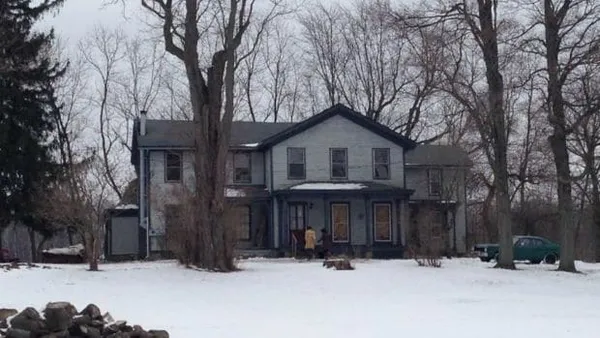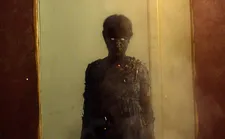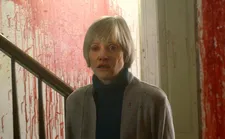 |
| We Are Still Here |
Every so often a horror film comes along which, for all its use of familiar devices, has a clear voice of its own. We Are Still Here is one such film, telling the tale of a recently bereaved middle aged couple who want to settle down somewhere away from the city, but make a deadly mistake in their choice of house. It’s beautifully shot and as bleak at its core as the snowy landscape outside, but it’s also wittily scripted and blackly humorous. I was delighted to get the chance to speak to director Ted Geoghegan about how it came to be and how he felt when introducing it at this year’s Film4 Frightfest.
“It was so much fun!” he says at once, full of warmth and enthusiasm. “I’d heard for years how awesome Frightfest was, with the atmosphere and the audience, I was really excited by it. But then when I showed my movie I was incredibly nervous because the audience was so quiet. I thought, oh no, they hate it, but then afterwards I went on Twitter and it had just exploded. All these people really liked it. I felt like it was being watched by a group of scholars who could only let themselves gush when it was over.”
I’d heard that it was inspired by Lucio Fulci’s The House By The Cemetery, so enquire about that.
 |
| We Are Still Here |
“That is correct,” says Ted. “The original project was pitched to me by a friend who is also a filmmaker and he wanted to do something based on The House By The Cemetery and I said I’d love to because that’s my favourite Fulci movie ever, so that’s where the script came from, which I wrote, and then when it was done I fell in love with it - I loved so much that I felt I had to direct it myself even though I’d never directed anything before except videos, so I said to the guy who was supposed to be directing it, if you don’t mind I’ll shop around to see if this is something I could do myself, and he gave me his blessing. My friend Travis Stevens, who’s a producer, saw it and thought it had merit, and Dark Sky financed it, so we were off and running. I wanted it to be a love letter to all of the quirky melodramatic eurohorror I grew loving. I really miss melodrama and classically structured weird horror. I feel as if a lot of of the films we see today, it’s not that they’re bad – some of them, like The Conjuring and Sinister, I like a lot – but they are structured in a way that’s really designed to appeal to modern audiences, with everything wrapped up in a nice tidy bow at the end, and i wanted to do something different with a structure that was weird. I didn’t want any of the loose ends tied up at the end.”
Alongside the Fulci references, the spirit of HP Lovecraft looms large over the film. We are, after all, in Massachusetts...
“There’s definitely a lot of Lovecraft,” Ted agrees. “I feel as though Fulci had a bit of Lovecraft in him even if he didn’t know it. There’s that love of the north east and New England. So yes, there are quite a few Lovecraft references in the film. Originally there were substantially more. It was a very Lovecrafty story and the town was like a Cthulhu cult, but I felt it was too much, so I toned it down a lot but there are still subtle references. The town they live in is Aylesbury, one of the fictional Lovecraft towns, and one character remarks that the Dagmar family used to sell corpses to the university over in Essex County – that’s Miskatonic University.”
 |
| Barbara Crampton |
He first found out about Lovecraft through watching the films of Stuart Gordon, he explains. “From Beyond and Re-Animator persuaded me that this was someone I needed to check out.”
Wasn’t it nerve-racking taking on something that was so important to him as his directorial debut?
”It was,” he concedes, “but I wouldn’t have taken on anything as my first film if I didn’t love it too much. It had to be something that felt right and was near and dear to my heart. Even though I’m in my mid thirties and the movie is about people in their mid fifties who have suffered a terrible loss, it still felt very personal to me somehow.”
As well as directing the film, he had full control over casting, enabling him to put together a strong team.
“Barbara Crampton is a very dear friend of mine. We’ve known each other for years so I was very fortunate her schedule permitted her to be part of the film. Then there’s Larry Fessenden who lives here in NYC, not far from me. We meet up and have pints from time to time The rest I hired through traditional means. They were some of the most wonderful people I could ever hope to make a move with and we all bonded very much.
“We had long discussions about how we wanted everyone to be portrayed but they did bring bits of themselves into each of the roles. It was a lot of fun to work with that. They brought with them so much experience that I knew that I would be a fool if I didn’t make use of that. I knew what I wanted but if anyone had an idea outside the box then I wanted to hear it.”
One of the striking things about the film is that it achieves what genre directors are always trying to achieve and makes ghosts creepy again. How did he do that?
“Very carefully,” he says. “It’s one of those things where there’s that revelatory moment on set when you realise that when you’ve written something scary it doesn’t immediately translate into something scary on the screen. There’s a shot when a woman looks down the hallway and sees a strange figure and it looks very plain if you just take what’s written on the page and exactly replicate that on screen, so we played around a lot to work out how to shoot that and what type of focus to use.
“With the Dagmar characters I wasn’t sure how that was going to land. I thought, what if they come off as non-imposing presences, just spectral homeowners?
The best thing about the shoot, he says, was working with so many friends. “Never in my wildest dreams would I have imagined making my directorial debut with so many people I love. I trust them also. They’re good at what they do. It was great to have a director of photography, an effects team, a producer and actors who were all close friends and who I knew would have my back 24/7.”
So what’s next for him?
“I would love to direct again,” he says. “I’m hoping to do something next year. I’m writing a new screenplay – it’s horror again. I can see myself working exclusively in genre films. They might not always be horror but I think they’ll always have something weird about them. I can’t see myself doing romantic comedy or an Oscar winning drama, somehow.”
We Are Still Here is released on DVD on Monday, October 19. Watch a clip from behind the scenes of the film:





















